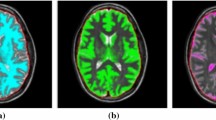Abstract
Purpose
Segmentation of facial soft tissues is required for surgical planning and evaluation, but this is laborious using manual methods and has been difficult to achieve with digital segmentation methods. A new automatic 3D segmentation method for facial soft tissues in magnetic resonance imaging (MRI) images was designed, implemented, and tested.
Methods
A region growing algorithm based on local energy functions, using intensity similarities among neighboring regions as criteria, was developed. This local energy function includes the neighborhood relationships not only in the same dataset but from other training datasets. This approach differs from previous studies where the prior information was represented as manual segmented atlases. In this study, a consensus of many datasets, none of which was labeled a priori, is used to guide the segmentation. The method was tested in MRI scans for adult facial structures. MRI scans were obtained from the Alzheimer’s disease neuroimaging initiative database. Comparison was made to results from expert manual segmentation and region growing techniques.
Results
The volumetric overlap between automated 3D segmentation results and the ground truth was 82.6% for masseter and 78.8% for temporalis tissues.
Conclusion
A new automated method to segment various facial soft tissues was implemented and the results compared with standard region growing results. The proposed method shows 3.9% improvement in accuracy over the standard method. Reduction in segmentation errors was consistently achieved in MRI scans.
Similar content being viewed by others
References
Farrugiaa ME, Bydder GM, Francis JM, Robson MD (2007) Magnetic resonance imaging of facial muscles. Clin Radiol 62: 1078–1086
Xia JJ, Gateno J, Teichgraebe J, Christensen A, Lasky R, Lemoine A, Liebschner M (2007) Accuracy of the computer-aided surgical simulation (CASS) system in the treatment of patients with complex craniomaxillofacial deformity: a pilot study. J Oral Maxillofac Surg 65: 248–254
Ulusoy I, Akagunduz E, Sabuncuoglu F, Gorgulu S, Ucok O (2010) Use of the dynamic volume spline method to predict facial soft tissue changes associated with orthognathic surgery. Oral Surg Oral Med Oral Pathol Oral Radiol Endod 110: e17–e23
Richarda N, Dojat M, Garbay C (2007) Distributed Markovian segmentation: application to MR brain scans. Pattern Recognit 40: 3467–3480
Rohlfing T, Brandt R, Menzel R, Russakoff DB, and Maurer CR (2005) Quo vadis, atlas-based segmentation, chap 11. In: Suri J, Wilson DL, Laxminarayan S (eds) The handbook of medical image analysis: registration models, vol 3. Kluwer Academic/Plenum Publishers, New York, pp. 435–486
Olszewski R, Liu Y, Duprez T, Xu TM, Reychler H (2009) Three-dimensional appearance of the lips muscles with three-dimensional isotropic MRI: in vivo study. Int J Comput Assist Radiol Surg 4: 349–352
Booma HPW, Van Spronsen PH, Van Ginkel FC, Van Schijnde RA, Castelijns JA, Tuinzing DB (2008) A comparison of human jaw muscle cross-sectional area and volume in long- and short-face subjects, using MRI. Arch Oral Biol 53: 273–281
Sharma N, Aggarwal LM (2010) Automated medical image segmentation techniques. J Med Phys 35: 3–14
Noble JH, Warrenb FM, Labadie RF, Dawant BM (2008) Automatic segmentation of the facial nerve and chorda tympani using image registration and statistical priors. In: Proceedings of the SPIE, The International Society for Optical Engineering, pp 69140P-1–69140P-10
Ng HP, Liu J, Huang S, Ong SH, Foong KWC, Goh PS, Nowinski WL (2008) An improved shape determinative slice determination method for patient-specific modeling of facial anatomical structure. Int J Comput Assist Radiol Surg 3: 221–230
Leemput KV, Maes F, Vandermeulen D, Suetens P (1999) Automated model based tissue classification of MR images of the brain. IEEE Trans Med Imaging 18: 897–908
Sabuncu MR, Yeo BTT, Leemput KV, Fischl B, Golland P (2010) A generative model for image segmentation based on label fusion. IEEE Trans Med Imaging 29: 1714–1729
Li SZ (2009) Markov random field modeling in image analysis (Advances in pattern recognition)
Isoardi RA, Oliva DE, Mato G (2011) Maximum evidence method for classification of brain tissues in MRI. Pattern Recognit Lett 32: 12–18
Bouman CA, Thompson AM, Brown JC, Kay JW (1995) Markov random fields and stochastic image models. IEEE international conference on image processing tutorial. http://dynamo.ecn.purdue.edu/~bouman/publications/Index-Tutorials.html
Alzheimer’s disease neuroimaging initiative, http://www.loni.ucla.edu/ADNI
Amira 3-D scientific visualization and data analysis package (ZIB, Berlin, Germany; Indeed–visual concepts GmbH, Berlin, Germany; TGS Inc., San Diego, CA)
Pan Z, Lu J (2007) A Bayes-based region-growing algorithm for medical image segmentation. Comput Sci Eng 9: 32–38
Author information
Authors and Affiliations
Corresponding author
Rights and permissions
About this article
Cite this article
Rezaeitabar, Y., Ulusoy, I. Automatic 3D segmentation of individual facial muscles using unlabeled prior information. Int J CARS 7, 35–41 (2012). https://doi.org/10.1007/s11548-011-0567-3
Received:
Accepted:
Published:
Issue Date:
DOI: https://doi.org/10.1007/s11548-011-0567-3




